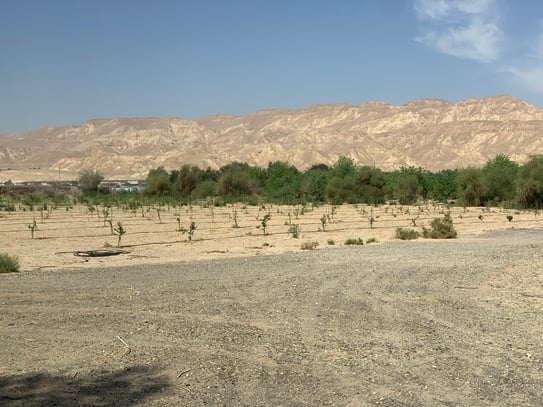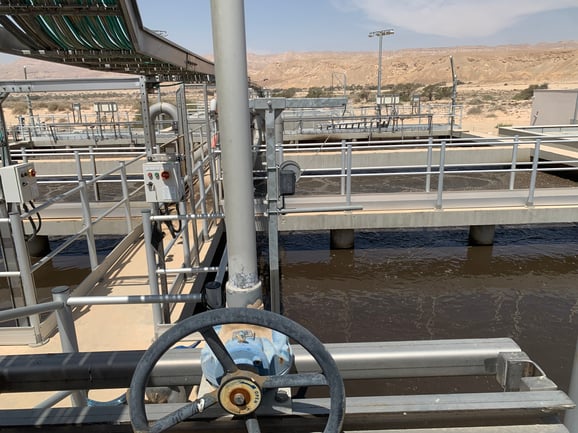Day Eight – The Edge of Nations
By: Ian Stephens '25
This article is part of a series of reflections prepared by students enrolled in the Texas A&M School of Law 2023 Global Field Studies Program: Israel. Click here to visit the entire series.
May 15th began at Kibbutz Ketura, where we had arrived the day before. The day’s schedule would bring us well across the hyper-arid Arava Valley, but in the background lay an event that had loomed over every day in Israel. As was typical of our time in Israel, this event was characterized by diametrically different historical perspectives.
Nakba Day, “catastrophe” in Arabic, is commemorated each fifteenth of May by Palestinians and other Arabs to align with the date of the Israeli Declaration of Independence. To Israelis, their Independence Day (which this year was celebrated in late April because of the Hebrew calendar) represents the birth of their nation and escape from Europe following the Holocaust. To Palestinians, the day is one of mourning that commemorates the destruction of Palestinian society and expulsion of the majority of the Palestinian people from their homelands.
Our visit to Israel had been influenced by ethnic conflict in the region to a greater degree than was expected of a study of wastewater regulation. We came expecting that our chief challenge would be to convince the Israeli government that Laguna Technologies produced a safe product. We soon discovered that our primary obstacle was in fact to overcome Israeli national policy toward Laguna’s potential customers, the Negev Bedouins. During our visit, it became clear that the policy of resettling the Bedouins into cities and the fear that a population alien to mainstream Israeli society may pose a security risk were more important factors for the Israeli government’s resistance to the deployment of Laguna’s wastewater treatment technology than were health and safety or economic concerns.
The Bedouins, an Arab Muslim population, had been caught up in the long aftermath of the Nakba and Israel’s independence such that a seemingly mundane issue like sewage water had become interwoven with identity and national security. It seemed appropriate then, that our time in Israel was marked not only by Nakba Day but also by Jerusalem Day a few days later. This holiday celebrates Israel’s capture of East Jerusalem–to Israelis the reunification of the city–during the 1967 Six-Day War with Egypt, Jordan, and Syria. This war both saw Israel victorious through the greatest threat to its independence to date and saw Israel take control of the West Bank, today the most important region of the Palestinian Territories. The differing consequences and perceptions of this event encapsulate the conflict..
Whereas the Bedouin way of life has been forged to fit the desert over many generations, modern industrialized society places greater demands on the delicate ecosystem. Our first stop of the day was to the experimental orchards maintained on the grounds of Kibbutz Ketura, amidst its wide-ranging rows of date palms, by the Arava Institute’s Center for Sustainable Agriculture. Here, delicately placed between Jordanian and Israeli mountain ranges, scientists of the Arava Institute attempted to grow novel new plants and trees from the sandy soil.

The Arava’s Institute's experimental orchard with Kibbutz Ketura’s date orchards in the background.
Impressive feats of engineering and concerted efforts of the Israeli state have made the desert bloom. But even with such achievements, our host explained, desert agriculture remained inherently unsustainable. Here, the Center for Sustainable Agriculture attempted to curate agricultural plants well suited for the hyper-arid conditions of the Arava and for the brackish water that ran through the region’s irrigation. Perhaps one day, it can only be imagined, the myrrh, marula, and neem pioneered here would spread across the region.
Leaving the Kibbutz, we made our way to a wastewater treatment plant serving some three thousand people living on kibbutzim in the area. Our third such plant of the trip was the smallest. Its management fell to a team of one man and his dog who kept the ship afloat three hundred and sixty-five days a year. Despite its size, though, this plant was not significantly different from the behemoth at Shafdan that served millions of people in the Tel Aviv metropolitan region.

The small sewage treatment plant that treats water from Ketura and several other kibbutzim
Later in the day, we arrived at the southernmost point in Israel: the city of Eilat, Israel’s most popular tourist destination where Israel, Jordan, Egypt, and Saudi Arabia can all be seen from its cobalt coast. A “dry talk” revealed the secrets of the Gulf of Aqaba’s coral reefs, more resilient than any other on Earth to the effects of climate change. The corals of Eilat, it seemed, may be around long after those of Australia and the Bahamas have bleached and died.

The Gulf of Aqaba as viewed from Eilat
We soon saw the life of these formations of anthozoa and the brilliant abundance and color of their fish ourselves. After an ill-advised, barefoot trek across sunbaked sand, the ocean came alive before our eyes as we peered into its depths beneath our snorkels.
Following a chance to enjoy the Red Sea, some chose to remain in Eilat for dinner and a hike almost out of the country, while others returned to the Kibbutz to enjoy the cool night air, ready to visit yet another sea the following day.
Learn more about Texas A&M University School of Law's Global Law and Policy Program, Aggie Dispute Resolution Program, and Energy, Environmental, and Natural Resource Systems Law Program
